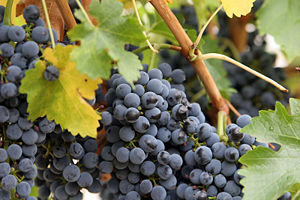Vitis
| Grapes | |
|---|---|
 | |
| Genus: | Vitis |
| Family: | Vitaceae |
| Type: | Vines |
| Weediness: | All species can be agressive |
| Pollination: | Insects |
| Toxicity and edibility: | Fruits and leaves are edible |
A grape is the fruit that grows on the woody vines of the family Vitaceae. Grapes grow in clusters of 6 to 300, and can be black, blue, golden, green, purple, red, pink, brown, peach or white.
Description[edit | edit source]
Plants in this genus are woody vines which climb using tendrils. The alternate leaves are simple, palmately veined and often lobes. Flowers are produced in clusters of 6-300. The fruits are berries with 1-6 hard seeds.
Growing conditions[edit | edit source]
Species[edit | edit source]
Many species of grapevines exist, including:
- Vitis vinifera, the European winemaking grapevine. Native to virtually all of mainland Europe.
- Vitis labrusca, the North American table and grape juice grapevines, sometimes used for wine. Native to the Eastern U.S. and Canada.
- Vitis riparia, a wild vine of North America, sometimes used for winemaking and for jam. Native to the entire Eastern U.S. and north to Quebec.
- Vitis rotundifolia, the muscadines, used for jams and wine. Native to the Southeastern U.S. from Delaware to the Gulf of Mexico.
- Vitis aestivalis, the variety Norton (AKA Cynthiana) is used for winemaking
- Vitis lincecumii (also called Vitis aestivalis or Vitis lincecumii), Vitis berlandieri (also called Vitis cinerea var. helleri), Vitis cinerea, Vitis rupestris are used for making hybrid grapevines and for pest-resistant rootstocks.
- Vitis arizonica A desert grapevine found in the southwestern US that is hardy against extremes of temperature. Can be used for wines.
- Vitis californica A grapevine important to the California wine industry for its rootstock which is able to withstand pests and cooler weather. Native to California and Oregon.
- Vitis vulpina Frost grape. Native to the Midwest east to the coast up through New York.
There are many varieties of grapevines; most are cultivars of V. vinifera.
Hybrid grapes also exist, and these are primarily crosses between Vitis vinifera and one or more varieties of Vitis labrusca, ../Vitis riparia/ or Vitis aestivalis. Hybrids tend to be less susceptible to frost and disease (notably phylloxera), but wine from some hybrids may have a little of the characteristic "foxy" odor of Vitis labrusca.
Uses[edit | edit source]
They can be eaten raw or used for making jam, grape juice, jelly, wine and grape seed oil. Cultivation of grapevines occurs in vineyards, and is calleviticulture. One who studies and practices growing grapes for wine is called a viticulturalist.
Raisins are the dried fruit of the grapevine, and the name actually comes from the French word for "grape". Wild grapevines are often considered a nuisance weed, as they cover other plants with their usually rather aggressive growth.
The leaves of the grape vine itself are considered edible and are used in the production of dolmades.
Maintenance[edit | edit source]
The most important maintenance requirement for grapes is regular pruning. Vines should be pruned back to spurs while dormant, in order to ensure good air circulation and keep the plants from getting out of hand.
Adequate calcium should be maintained in the soil if growing for fruit.
Propagation[edit | edit source]
Cultivars are almost always grafted.
Harvesting[edit | edit source]
Pests and diseases[edit | edit source]
Scorch, Wilt, Dieback
- Xylella fastidiosa (Pierce’s Disease)
- Eutypa lata
- Eutypa armeniacae
- Aspergillus niger
- Botrytis cinerea
- Lasoidiplodia theobromae
- Grape Phylloxeran: Daktulosphaira vitifoliae
- Calico Scale: Eulecanium cerasorum
- European Fruit Lecanium Scale: Lecanium corni
- Oystershell Scale: Lepidosaphes ulmi
- Cottony Grape Scale: Pulvinaria vitis
- European Peach Scale: Parthenolecanium persicae
- Eastern Grape Leafhopper: Erythroneura comes
- Threebanded Leafhopper: Erythroneura tricincta
- Variegated Leafhopper: Erythroneura variabilis
- Virginiacreeper Leafhopper: Erythroneura ziczac
- Western Grape Leafhopper: Erythroneura vulnerata
- Grape Mealybug: Pseudococcus maritimus
- Obscure Mealybug: Psudococcus viburni
- Campylomma Bug: Campylomma verbasci
- Grape Tumid Gallmaker: Janetiella breviconda
- Grape Gall Midges: Schizomyia
- Grape Cane Girdler: Ampeloglypter ater
- Grape Cane Gallmaker: Ampeloglypter sesostris
- Rose Chafer: Macrodactylus subspinosus
- Japanese Beetle: Popillia japonica
- Apple Flea Beetle: Altica foliacea
- Apple Twig Borer: Amphicerus bicaudatus
- Grape Flea Beetle: Altica chalybea
- Grape Curculio: Craponius inaequalis
- Grapeleaf Skeletonizer: Harrisina americana
- Achemon Sphinx: Eumorpha achemon
- Eightspotter Forester: Alypia octomaculata
- Grape Berry Moth: Endopiza viteana
- Grapevine Root Borer: Vitacea polistiformis
- Redbanded Leafroller: Argyotaenia velutinana
- Spotted Cutworms: Xestia spp.
- Virginiacreeper Sphinx: Darapsa myron
- Western Grapeleaf Skeletonizer: Harrisia brillans
- Whitelined Sphinx: Hyles lineata
- Grape Sawfly: Erythraspides vitis
- Yellowjackets
- Leafcutter Bees
- Grape Erineum Mite: Colomerus vitis
- European Red Mite: Panonychus ulmi
Gallery[edit | edit source]
-
A bunch of grapes
-
Autumn Royal grapes
-
Red and green grapes
-
Red grapes
-
Flame seedless grapes
-
Foliage of the Concord grape plant
-
Young grapes
-
Guadalupe Valley Vineyards, Ensenada, Baja California, Mexico / Viñedos del Valle de Guadalupe, Ensenada, Baja California, México
-
Guadalupe Valley Vineyards, Ensenada, Baja California, Mexico / Viñedos del Valle de Guadalupe, Ensenada, Baja California, México
-
A vineyard in the Canton of Geneva.
References[edit | edit source]
- Cranshaw, Whitney (2004). Garden Insects of North America: The Ultimate Guide to Backyard Bugs. Princeton University Press. pp. 625–626.
{{cite book}}: Cite has empty unknown parameter:|coauthors=(help) - Pippa Greenwood, Andrew Halstead, A.R. Chase, Daniel Gilrein (2000). American Horticultural Society Pests & Diseases: The Complete Guide to Preventing, Identifying, and Treating Plant Problems (First Edition ed.). Dorling Kindersley (DK) Publishing, inc. p. 204.
{{cite book}}:|edition=has extra text (help); Cite has empty unknown parameter:|coauthors=(help)CS1 maint: multiple names: authors list (link)










